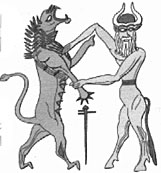
There are certain hints that the Minoan civilization might have been influenced by, or even descended from, the Sumerian / Mesopotamian civilization of a thousand years earlier. According to David Rohl (Legend: The Genesis of Civilisation, London, Arrow Books 1998), the Phoenecians and Canaanites who inhabited the coast of what is now Israel and Lebanon came from Sumeria (Ur, Uruk, Eridu) at the same time as others from the same region went to Bahrain and then to the Upper Nile, some time around 3000 BC. If the Minoan culture was actually derived from the Sumerian, as seems not unlikely, it must have happened before writing became common in Sumer, around 3000 BC. Rohl's dates tend to be more recent than the conventional dates, so when Rohl mentions 3000 BC, he refers to a time conventionally dated rather earlier, perhaps 3500 BC.
A thousand years later, around the time of the Minoan civilisation and later, the Phoenecians of Byblos (near present-day Beirut) were great sailing traders who had a long trading history with Egypt. They knew Amnissos, the port of Knossos, and presumably traded there. The Minoans likewise were great sailing traders, who are known to have traded all around the Eastern Mediterranean and the Aegean. There must have been at least some cultural interchange between these traders who shared the same sea and presumably many of the same ports. Minoan pottery from around 2500 BC is reminiscent of Syrian pottery of the same date. This was at the height of the Ebla trading system, which traded at least from the Persian Gulf to the Black Sea, and from Afghanistan to Byblos, though the Eblaites left the sea trade to Byblos.
 |
| Part of a Sumerian seal from about 2000 BC. Rohl ,1998 inteprets the bull-man as Gilgamesh (Rohl,p170), but the bull-man image goes back to much earlier times. |
The bull was important in the Minoan religion and culture, as it was in Sumer. Gilgamesh (who, according to Rohl, ruled in Uruk around 2487 BC) is shown as half-bull, half-man, as is the Cretan Minotaur in the much later Greek legend. The picture on the seal looks remarkably like depictions of the Minotaur, and it is possible that the Greeks knew of such depictions as well as of the bull cult in Minoan Crete. There are many other bull-man representations in images from Mesopotamia. Sometimes the body is bull in part or whole and the head human, sometimes the reverse. Perhaps there were similar Minoan images known to the Greeks, but as yet not discovered by modern archaeologists. So, one can assume that the bull-man "monster" was an image known to the Early Greeks of Minoan times.
There are other similarities in the iconography of the Minoan and Sumerian cultures. The Knossos object that is said to represent bull horns looks remarkably like an Altar to the Moon on Bahrain, which Rohl says is from the Sumerian diaspora. According to Castleden, in Minoan Crete, the bull and the moon were probably aspects of the same deity, who later became Poseidon in Classical Greece. Poseidon, perhaps not coincidentally, was the Greek god of earthquakes. This linkage ties the Sumerian (according to Rohl) Altar in the Temple of the Moon even more closely to the similarly shaped bull-horn shape that was a religious element in Knossos.
Beyond these, there were other similarities between pre-literate Sumerian religious elements and those of Minoan Crete. According to Georges Roux (Ancient Iraq, Penguin 1992), the primary religious symbols in the Halaf and Ubaid periods of Sumer (covering about 5000 BC to 3300 BC) were the double-axe, the bull-head, doves, and women. According to Castleden (Minoans: Life in Bronze Age Crete, London: Routledge, 1990), the double-axe and the bull-head were the primary religious symbols for the Minoans, and doves were associated with goddesses to the extent that sometimes the dove was taken to represent the goddess. In both Sumer and Minoan Crete, a priestess would "become" the goddess in some ceremonies.
Not only the iconography, but also the architecture seems to have some connection with that of Sumer. The typical Sumerian temple, at least from Ubaid times, had a "tripartite" structure. A long rectangular central courtyard was flanked on both sides by a complex of small rooms, and at one end may have had a crosswise rectangular large antechamber. The Minoan temple-palaces have this same structure, grown large. A long central courtyard, kinown in Knossos as the Bull court, is flanked by a very complex system of small rooms, and at one end (at least in Knossos) there was a crosswise rectangular room.
The architectural similarities extend to the so-called tholos tombs, beehive-shaped circular structures, which were used in Halaf time (5500 BC to 4500BC) as houses, but survived in more northern Mesopotamia as tombs into the Ubaid times (up to about 3750 BC). They appear again in Minoan Crete, and more particularly in later times in Mycenean Greece, where they were first discovered (e.g. the so-called "Treasury of Atreus in Mycenae).
It seems that the Minoan culture owed a great deal to that of pre-literate Sumer, and that contacts were maintained with the Levantine coast, which was often part of Mesopotamian empires over the years. Sumer almost always had trading relations as far afield as Anatolia and India, even as far back as 4000 BC.